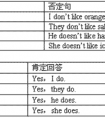Readandfillintheblanks. 请你根据首字母和汉语提示写单词,将下列句子补充完整。1. Iwanttosendthisl____ (信) tomymother.2. Howmanyp___ (明信片) arethere?3. Thi-五年级英语
这些名词变成复数时,都要改 -f (e) 为 v,再加 -es。
3. -f 结尾的名词直接加 -s 变复数歌诀:海湾边、屋顶上,首领奴仆两相望;谁说他们无信仰,证据写在手帕上。
例如:gulf, roof, chief, serf, belief, proof, handkerchief,这些名词变复数直接加 -s。
注:scarf(围巾;披风) 可以先改 f 为 ve 再加-s,也可直接加 -s。
4. 辅音字母 + y 结尾的名词,把 y 变 i 加 -es。
例如:baby → babies, country → countries, family → families;而 -y 前是元音时,-y 不变,直接加 -s。例如:day → days, boy → boys
5. 以 -o 结尾的名词变复数时,多数直接加 -s。
例如:radio → radios, piano → pianos, kangaroo → kangaroos;有的须加 -es,中学课本中有几个这样的单词,可以通过一句口诀来记忆:黑人英雄爱吃西红柿和土豆。
即:Negro → Negroes, hero → heroes, tomato → tomatoes, potato → potatoes;有的以 o 结尾的名词既可加 -s 也可加 -es。
例如:volcano (火山) → volcanos / volcanoes 等。
6. 名词复数的不规则变化需要特别记忆。
例如:man → men, woman → women, goose → geese, foot → feet, tooth → teeth, mouse → mice, louse (虱子) → lice, child → children, fish → fish, deer (鹿) → deer, sheep → sheep 等。
7. 初中课本中表示“某国人”的名词复数形式变化可通过歌诀记忆:中日不变英法变,其余 -s 加后面。
例如:Chinese → Chinese, Japanese → Japanese;
Englishman → Englishmen, Englishwoman → Englishwomen, Frenchman → Frenchmen, Frenchwoman → Frenchwomen;
American → Americans, Rusian → Rusians, Arab → Arabs, German → Germans 等。
8. 不可数名词一般只有单数形式,没有复数形式。有些不可数名词可借助单位词表示一定的数量。
例如:a cup of tea 一杯茶
, two piece of paper 两张纸, an item of news 一则新闻
考点名称:副词
- 副词:
用来修饰动词、形容词、其他副词或全句的词,表示时间、地点、程度、方式等。 - 分 类:
1) 时间和频度副词:
now,then,often,always,usually,early,today, lately, next,last,already,generally,frequently, seldom,ever,never,yet,soon,too, immediately, hardly,finally,shortly, before, ago,sometimes, yesterday.
2) 地点副词:
here, there, everywhere, anywhere, in, out, inside, outside, above, below, down, back, forward, home, upstairs, downstairs, across, along, round , around, near, off, past, up, away, on.
3) 方式副词:
carefully, properly, anxiously, suddenly, normally, fast, well, calmly, politely, proudly, softly, warmly
4) 程度副词:
much,little, very,rather,so,too,still, quite, perfectly, enough, extremely, entirely,almost, slightly.
5) 疑问副词:
how, when, where, why.
6) 关系副词:
when, where, why.
7) 连接副词:
how, when, where, why, whether. 副词的位置:
A、副词修饰动词(包括动名词和分词)时,通常位于被修饰动词的后面。
例:Shestudieshard.她学习努力。
B、副词修饰形容词是,通常放在该形容词的前面。
例:LiMingistooyoung.Hecan’tcarrytheheavybox. 李明太小,他搬不动这个重箱子。
C、副词修饰其他副词时,通常放在被修饰副词的前面。
例:Thegirlsingsverywell.这个女孩歌唱得非常好。副词用法:
副词在句中可作状语,表语,补语。
He works hard.
他工作努力。
You speak English quite well.
你英语讲的很好。
Is she in ?
她在家吗?
Let's be out.
让我们出去吧。
Food here is hard to get.
这儿很难弄到食物。
- 最新内容
- 相关内容
- 网友推荐
- 图文推荐
上一篇:LiMing,here'sthebus_____. [ ]A. stopB. stopsC. stoppedD. stopping-五年级英语
下一篇:Readandmatch. 把单数和复数匹配起来写在横线上。man baby child woman eyechildren men eyeswomenbabies-五年级英语
零零教育社区:论坛热帖子
| [家长教育] 孩子为什么会和父母感情疏离? (2019-07-14) |
| [教师分享] 给远方姐姐的一封信 (2018-11-07) |
| [教师分享] 伸缩门 (2018-11-07) |
| [教师分享] 回家乡 (2018-11-07) |
| [教师分享] 是风味也是人间 (2018-11-07) |
| [教师分享] 一句格言的启示 (2018-11-07) |
| [教师分享] 无规矩不成方圆 (2018-11-07) |
| [教师分享] 第十届全国教育名家论坛有感(二) (2018-11-07) |
| [教师分享] 贪玩的小狗 (2018-11-07) |
| [教师分享] 未命名文章 (2018-11-07) |






